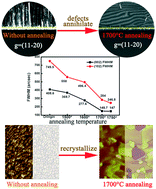当前位置:
X-MOL 学术
›
CrystEngComm
›
论文详情
Our official English website, www.x-mol.net, welcomes your feedback! (Note: you will need to create a separate account there.)
Defect evolution in AlN templates on PVD-AlN/sapphire substrates by thermal annealing
CrystEngComm ( IF 3.1 ) Pub Date : 2018-07-09 00:00:00 , DOI: 10.1039/c8ce00770e Jianwei Ben 1, 2, 3, 4, 5 , Xiaojuan Sun 1, 2, 3, 4 , Yuping Jia 1, 2, 3, 4 , Ke Jiang 1, 2, 3, 4, 5 , Zhiming Shi 1, 2, 3, 4 , Henan Liu 1, 2, 3, 4 , Yong Wang 1, 2, 3, 4, 5 , Cuihong Kai 1, 2, 3, 4, 5 , You Wu 1, 2, 3, 4, 5 , Dabing Li 1, 2, 3, 4
CrystEngComm ( IF 3.1 ) Pub Date : 2018-07-09 00:00:00 , DOI: 10.1039/c8ce00770e Jianwei Ben 1, 2, 3, 4, 5 , Xiaojuan Sun 1, 2, 3, 4 , Yuping Jia 1, 2, 3, 4 , Ke Jiang 1, 2, 3, 4, 5 , Zhiming Shi 1, 2, 3, 4 , Henan Liu 1, 2, 3, 4 , Yong Wang 1, 2, 3, 4, 5 , Cuihong Kai 1, 2, 3, 4, 5 , You Wu 1, 2, 3, 4, 5 , Dabing Li 1, 2, 3, 4
Affiliation

|
AlN is the key material to obtain high performance ultraviolet optoelectronic and microelectronic devices. To obtain high quality AlN, a high temperature annealing method is employed. However, the mechanism of thermal annealing on improving the quality of AlN needs to be further studied. In this work, we focus on the influence of high temperature thermal annealing on the defect evolution in AlN and study the mechanism. AlN epilayers grown by metal–organic chemical vapor deposition (MOCVD) were annealed at different temperatures. The results showed that the full width at half maximum of the (0002) and (10−12) planes for the AlN templates decreased to 147 and 246.8 arcsec after thermal annealing at 1750 °C. Meanwhile many voids appeared in the physical vapor deposition AlN layer. To reveal the mechanism of thermal annealing on improving the quality of AlN, the AlN grown by physical vapor deposition (PVD) was also annealed by high temperature annealing. Atomic force microscopy results showed that realignment and coalescence occurred in the PVD-AlN, which gave the evidence for defect reduction in AlN by the thermal annealing method as well as the existence of AlN voids. The results presented here can not only provide a deeper understanding of the mechanism of the thermal annealing, but also offer a direction to obtain high quality AlN templates.
中文翻译:

通过热退火在PVD-AlN /蓝宝石衬底上的AlN模板中的缺陷演变
AlN是获得高性能紫外光电和微电子器件的关键材料。为了获得高质量的AlN,采用高温退火方法。但是,需要进一步研究热退火改善AlN质量的机理。在这项工作中,我们集中于高温热退火对AlN中缺陷发展的影响,并研究其机理。通过金属有机化学气相沉积(MOCVD)生长的AlN外延层在不同温度下退火。结果表明,在1750°C的温度下退火后,AlN模板的(0002)和(10-12)平面的半峰全宽分别降至147和246.8 arcsec。同时,在物理气相沉积AlN层中出现许多空隙。为了揭示热退火改善AlN质量的机理,还通过高温退火对通过物理气相沉积(PVD)生长的AlN进行了退火。原子力显微镜结果表明,PVD-AlN中发生了重新排列和聚结,这为通过热退火法减少AlN的缺陷以及存在AlN空隙提供了证据。这里给出的结果不仅可以提供对热退火机理的更深入的了解,而且可以为获得高质量的AlN模板提供指导。这提供了通过热退火方法减少AlN缺陷以及存在AlN空隙的证据。此处给出的结果不仅可以提供对热退火机理的更深入了解,而且还可以为获得高质量AlN模板提供指导。这提供了通过热退火方法减少AlN缺陷以及存在AlN空隙的证据。此处给出的结果不仅可以提供对热退火机理的更深入了解,而且还可以为获得高质量AlN模板提供指导。
更新日期:2018-07-09
中文翻译:

通过热退火在PVD-AlN /蓝宝石衬底上的AlN模板中的缺陷演变
AlN是获得高性能紫外光电和微电子器件的关键材料。为了获得高质量的AlN,采用高温退火方法。但是,需要进一步研究热退火改善AlN质量的机理。在这项工作中,我们集中于高温热退火对AlN中缺陷发展的影响,并研究其机理。通过金属有机化学气相沉积(MOCVD)生长的AlN外延层在不同温度下退火。结果表明,在1750°C的温度下退火后,AlN模板的(0002)和(10-12)平面的半峰全宽分别降至147和246.8 arcsec。同时,在物理气相沉积AlN层中出现许多空隙。为了揭示热退火改善AlN质量的机理,还通过高温退火对通过物理气相沉积(PVD)生长的AlN进行了退火。原子力显微镜结果表明,PVD-AlN中发生了重新排列和聚结,这为通过热退火法减少AlN的缺陷以及存在AlN空隙提供了证据。这里给出的结果不仅可以提供对热退火机理的更深入的了解,而且可以为获得高质量的AlN模板提供指导。这提供了通过热退火方法减少AlN缺陷以及存在AlN空隙的证据。此处给出的结果不仅可以提供对热退火机理的更深入了解,而且还可以为获得高质量AlN模板提供指导。这提供了通过热退火方法减少AlN缺陷以及存在AlN空隙的证据。此处给出的结果不仅可以提供对热退火机理的更深入了解,而且还可以为获得高质量AlN模板提供指导。


























 京公网安备 11010802027423号
京公网安备 11010802027423号